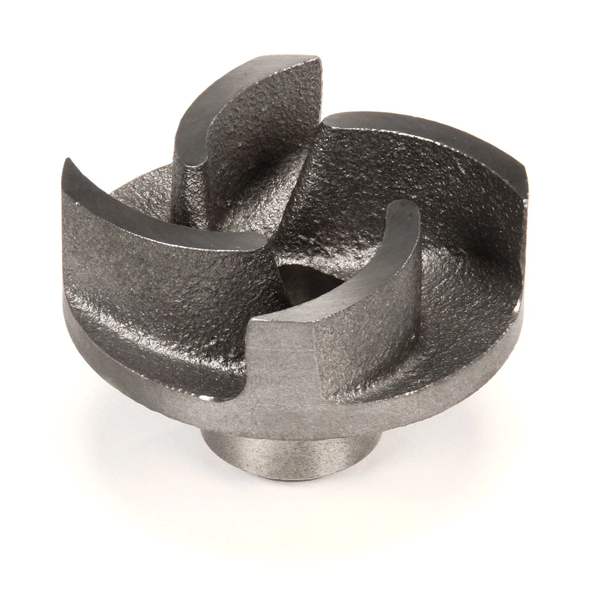
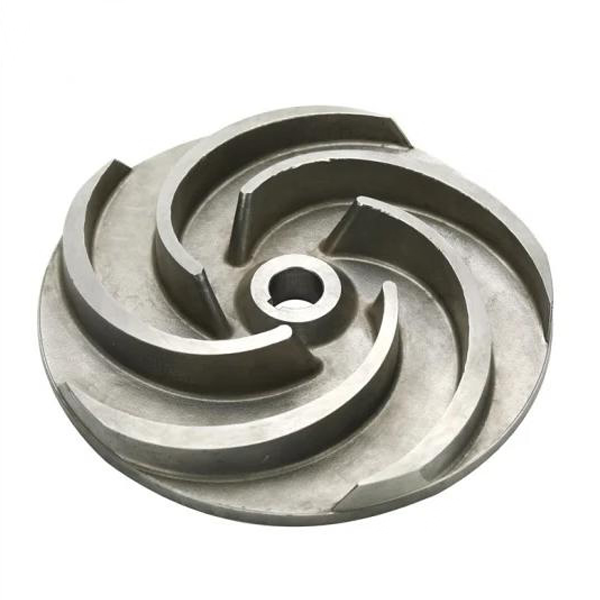
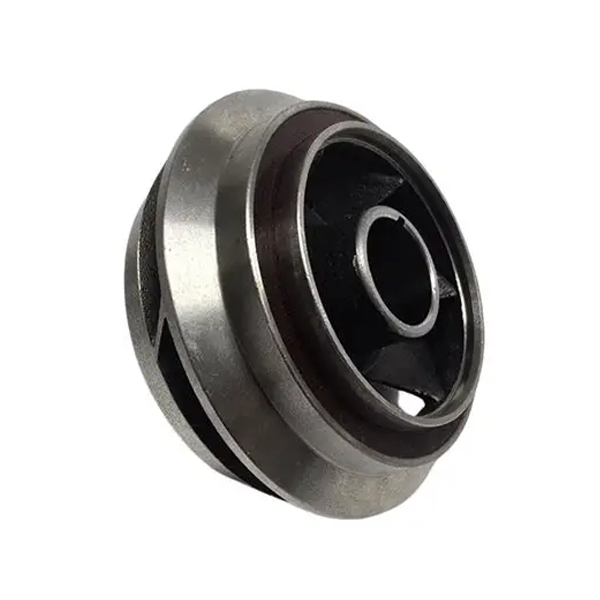
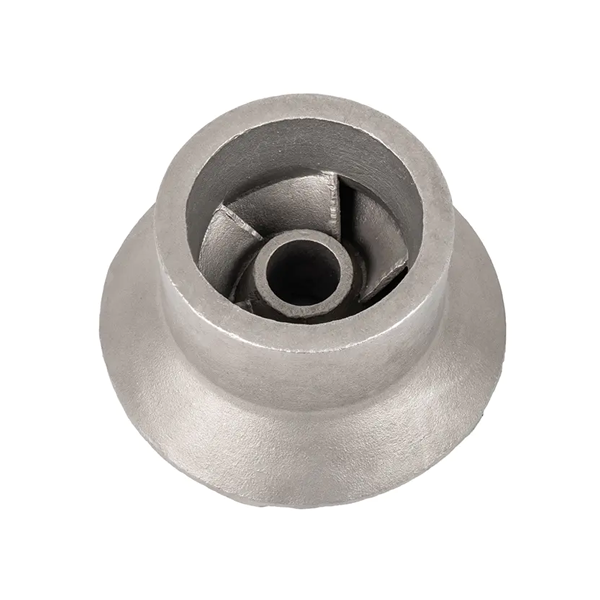
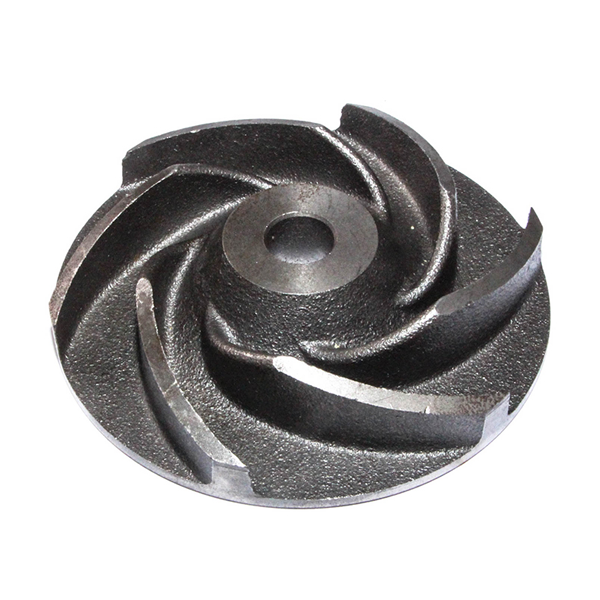

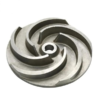
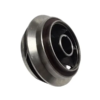
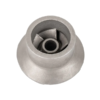
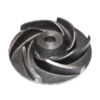
Our company’s cast iron impellers, primarily made of HT250 gray iron, utilize advanced design to minimize fluid leakage, achieving efficiencies of 80%-90%. Closed impellers utilize a double cover plate structure to reduce axial thrust and extend bearing life. Open impellers feature adjustable clearances for long-term stable operation. The wear-resistant material withstands harsh operating conditions, including acid and alkali corrosion and high and low-temperature fluctuations. We offer a variety of structural options, including open, closed, and semi-open, for diverse media, such as sewage with a solids content greater than 0.5% and chemical fluids.
Material: gray cast iron
Our cast iron parts are of high precision, wear resistance, low price and fast delivery, and are well received by customers
Material: Cast iron HT250/GG25
Standard/tollerance: EN1561-2011/GB/T 9439/GB/T 1348
Size and weight: According to drawing
High Efficiency
Optimized fluid dynamics design (such as blade profile, pitch angle, and twist) maximizes energy conversion efficiency and reduces turbulence and cavitation.
Typical performance: water pump impeller efficiencies exceeding 90%, and aircraft engine compressor impellers achieve isentropic efficiencies exceeding 85%.
Low Vibration and Noise
Dynamic balancing (residual unbalance <0.1 g·mm/kg) and modal analysis prevent resonance and reduce operating noise (e.g., centrifugal fan impeller noise <75 dB).
Wide Operating Condition Adaptability
Maintains stable performance under varying flow/pressure conditions (e.g., the "hump-free" feature of centrifugal impellers).
1. Energy and Power Industry
(1) Gas Turbine/Steam Turbine
Application: Power plants, ship propulsion
Impeller Type: Axial/Centrifugal compressor impeller, turbine blade
Features: High-temperature alloys (such as Inconel 718, single-crystal nickel-based alloys), resistant to temperatures above 1000°C.
Air-cooled design: Blades contain cooling channels inside (3D printing enables complex flow channels).
High speed: The impeller speed of gas turbines for power generation reaches 3000~15000 RPM.
(2) Water Turbine (Hydropower)
Type: Francis, Kaplan, Pelton impeller
Features:
Cavitation-resistant material: Stainless steel (06Cr13Ni4Mo) or tungsten carbide coating.
Large-scale: The impeller of the Three Gorges turbine exceeds 10 meters in diameter and weighs 450 tons. 2. Petroleum and Chemical Industry
(1) Centrifugal Pump Impeller
Application: Crude oil transportation, chemical process pump
Features: Corrosion-resistant materials: Duplex stainless steel (2205), Hastelloy (C276).
Sealing: Closed impeller design reduces leakage, efficiency reaches 85%~92%.
(2) Compressor Impeller (such as centrifugal compressor)
Application: Natural gas pressurization, refining process
Features: High strength and lightweight: Titanium alloy (Ti-6Al-4V) or 17-4PH stainless steel.
High pressure ratio: Single-stage pressure ratio can reach more than 4:1 (such as API 617 standard).
3. Aerospace
(1) Aircraft Engine Impeller
Type:
Compressor impeller (axial flow/centrifugal): aluminum alloy (front stage), titanium alloy (rear stage).
Turbine impeller: nickel-based single crystal blade (with film cooling holes).
Features: Extreme environment resistance: high temperature (>1500°C), high stress (centrifugal force exceeds 100,000 g). Precision manufacturing: Five-axis CNC machining blade surface tolerance ±0.03 mm.
4. Transportation
(1) Automotive turbocharger impeller
Material: High silicon aluminum alloy (such as A356-T6) or ceramic matrix composite (SiC).
Features: Lightweight: Impeller weight <200g, speed >200,000 RPM.
5. Industrial and Civil
(1) Heating, Ventilation and Air Conditioning (HVAC) fan impeller
Type: Centrifugal, Axial
Features: Low noise: Backward curved blade design, noise <60 dB (A).
Energy saving: EC motor + high-efficiency impeller comprehensive energy efficiency ratio >8.0.
1. General Impeller Specifications
Diameter (Outer Diameter): The maximum outer diameter of the impeller (unit: mm/inch), which directly affects flow rate and head/pressure.
Example: φ200mm, 8 inches
Number of Blades: Varies from 3 to 12, affecting efficiency and fluid characteristics.
Blade Shape: Forward-curved, backward-curved, or radial blades, affecting the performance curve.
Inlet/Outlet Width: Affects flow rate and velocity.
Material: Cast iron, stainless steel (e.g., 304/316), bronze, plastic (PP/PVDF), etc.
Shaft Hole Diameter: The dimension that matches the drive shaft (e.g., φ25mm, keyway specifications).
Balance Grade: G6.3 (general purpose), G2.5 (high precision), etc. 2. Example of Water Pump Impeller Specifications
Centrifugal Pump Impeller:
Model: 80-65-160
Inlet Diameter: 80mm
Outlet Diameter: 65mm
Impeller Diameter: 160mm
Flow Rate: 50m³/h
Head: 32m
Speed: 2900rpm
Open/Closed Impeller: Closed impeller for clean liquids, open impeller for liquids with impurities.
3. Example of Fan Impeller Specifications
Centrifugal Fan Impeller:
Diameter: φ500mm
Number of Blades: 6-12
Air Volume: 2000-5000m³/h
Total Pressure: 800-1200Pa
Material: Galvanized Steel/Aluminum Alloy
4. Turbine Impeller (e.g., Steam Turbine)
Blade Height/Chord Length: Precision designed to conform to gas dynamics.
Material: High-temperature-resistant alloy (e.g., Inconel).
High Efficiency
Optimized fluid dynamics design (such as blade profile, pitch angle, and twist) maximizes energy conversion efficiency and reduces turbulence and cavitation.
Typical performance: water pump impeller efficiencies exceeding 90%, and aircraft engine compressor impellers achieve isentropic efficiencies exceeding 85%.
Low Vibration and Noise
Dynamic balancing (residual unbalance <0.1 g·mm/kg) and modal analysis prevent resonance and reduce operating noise (e.g., centrifugal fan impeller noise <75 dB).
Wide Operating Condition Adaptability
Maintains stable performance under varying flow/pressure conditions (e.g., the "hump-free" feature of centrifugal impellers).
1. Energy and Power Industry
(1) Gas Turbine/Steam Turbine
Application: Power plants, ship propulsion
Impeller Type: Axial/Centrifugal compressor impeller, turbine blade
Features: High-temperature alloys (such as Inconel 718, single-crystal nickel-based alloys), resistant to temperatures above 1000°C.
Air-cooled design: Blades contain cooling channels inside (3D printing enables complex flow channels).
High speed: The impeller speed of gas turbines for power generation reaches 3000~15000 RPM.
(2) Water Turbine (Hydropower)
Type: Francis, Kaplan, Pelton impeller
Features:
Cavitation-resistant material: Stainless steel (06Cr13Ni4Mo) or tungsten carbide coating.
Large-scale: The impeller of the Three Gorges turbine exceeds 10 meters in diameter and weighs 450 tons. 2. Petroleum and Chemical Industry
(1) Centrifugal Pump Impeller
Application: Crude oil transportation, chemical process pump
Features: Corrosion-resistant materials: Duplex stainless steel (2205), Hastelloy (C276).
Sealing: Closed impeller design reduces leakage, efficiency reaches 85%~92%.
(2) Compressor Impeller (such as centrifugal compressor)
Application: Natural gas pressurization, refining process
Features: High strength and lightweight: Titanium alloy (Ti-6Al-4V) or 17-4PH stainless steel.
High pressure ratio: Single-stage pressure ratio can reach more than 4:1 (such as API 617 standard).
3. Aerospace
(1) Aircraft Engine Impeller
Type:
Compressor impeller (axial flow/centrifugal): aluminum alloy (front stage), titanium alloy (rear stage).
Turbine impeller: nickel-based single crystal blade (with film cooling holes).
Features: Extreme environment resistance: high temperature (>1500°C), high stress (centrifugal force exceeds 100,000 g). Precision manufacturing: Five-axis CNC machining blade surface tolerance ±0.03 mm.
4. Transportation
(1) Automotive turbocharger impeller
Material: High silicon aluminum alloy (such as A356-T6) or ceramic matrix composite (SiC).
Features: Lightweight: Impeller weight <200g, speed >200,000 RPM.
5. Industrial and Civil
(1) Heating, Ventilation and Air Conditioning (HVAC) fan impeller
Type: Centrifugal, Axial
Features: Low noise: Backward curved blade design, noise <60 dB (A).
Energy saving: EC motor + high-efficiency impeller comprehensive energy efficiency ratio >8.0.
1. General Impeller Specifications
Diameter (Outer Diameter): The maximum outer diameter of the impeller (unit: mm/inch), which directly affects flow rate and head/pressure.
Example: φ200mm, 8 inches
Number of Blades: Varies from 3 to 12, affecting efficiency and fluid characteristics.
Blade Shape: Forward-curved, backward-curved, or radial blades, affecting the performance curve.
Inlet/Outlet Width: Affects flow rate and velocity.
Material: Cast iron, stainless steel (e.g., 304/316), bronze, plastic (PP/PVDF), etc.
Shaft Hole Diameter: The dimension that matches the drive shaft (e.g., φ25mm, keyway specifications).
Balance Grade: G6.3 (general purpose), G2.5 (high precision), etc. 2. Example of Water Pump Impeller Specifications
Centrifugal Pump Impeller:
Model: 80-65-160
Inlet Diameter: 80mm
Outlet Diameter: 65mm
Impeller Diameter: 160mm
Flow Rate: 50m³/h
Head: 32m
Speed: 2900rpm
Open/Closed Impeller: Closed impeller for clean liquids, open impeller for liquids with impurities.
3. Example of Fan Impeller Specifications
Centrifugal Fan Impeller:
Diameter: φ500mm
Number of Blades: 6-12
Air Volume: 2000-5000m³/h
Total Pressure: 800-1200Pa
Material: Galvanized Steel/Aluminum Alloy
4. Turbine Impeller (e.g., Steam Turbine)
Blade Height/Chord Length: Precision designed to conform to gas dynamics.
Material: High-temperature-resistant alloy (e.g., Inconel).

The impeller is the core component of turbomachinery (such as pumps, fans, compressors, turbines, etc.). Its production process involves multiple links such as material selection, precision machining, and quality control.
1. Material selection
The impeller needs to select appropriate materials according to the working environment (temperature, pressure, medium corrosiveness, etc.) Metal materials: cast iron, cast steel, stainless steel (such as 304, 316), aluminum alloy, titanium alloy, nickel-based alloy (high temperature environment), etc.
2. Production process
(1) Design and modeling
Use CAD software (such as SolidWorks, UG) for three-dimensional design to determine the blade shape (twisted blades, straight blades, etc.), inlet/outlet angles, flow channel dimensions, etc.Optimize fluid performance through CFD (computational fluid dynamics) simulation to ensure that efficiency and cavitation characteristics meet the standards.
(2) Blank preparation
Casting (suitable for complex impellers):
Sand casting (low cost, small batch).
Precision casting (such as lost wax method, for high-precision impellers).
Die casting (aluminum alloy impellers, large-scale production). Forging (high strength requirements): Machining after die forging, suitable for high-pressure turbine impellers. Welding/Assembly: Split impellers (such as large fan blades) are spliced by welding.
(3) Machining CNC machining: Five-axis CNC machining centers are used for complex curved blades. Turning of rotating parts such as hubs and shaft holes. Electrospark machining (EDM): Processing of fine structures of high-hardness materials (such as titanium alloys). Polishing and deburring: Manual or robotic polishing to reduce the impact of surface roughness on fluid efficiency.
(4) Heat treatment and surface treatment Heat treatment: Quenching and tempering improve the hardness and fatigue resistance of metal impellers. Surface treatment: Spraying (such as tungsten carbide coating for wear resistance). Electroplating (corrosion protection). Anodizing (aluminum alloy impellers).
(5) Dynamic Balancing Test
The vibration of the impeller during rotation is detected on a dynamic balancing machine. Imbalance is corrected by removing or adding weight (such as counterweight screws) to prevent failure during high-speed operation.
(6) Quality Inspection
Dimensional Inspection: Coordinate Measuring Machine (CMM) verifies key dimensions.
Non-destructive Testing: X-ray and ultrasonic testing are used to detect internal defects.
Performance Testing: Actual operating condition simulation (flow rate, pressure, efficiency testing).

Raw Material Control
Metal Material Composition:
Spectroscopic analysis ensures that alloy composition meets standards (e.g., Cr and Ni content in stainless steel).
Impurity elements (e.g., S and P) must be strictly controlled to prevent hot brittleness or intergranular corrosion.
Molding Sand/Mold Material (Sand Casting):
Inspect the sand's refractoriness, permeability, and strength to avoid defects such as porosity and sand sticking in the casting.

Mold/wax pattern quality and dimensional accuracy: Molds must be verified using coordinate measurement (CMM) to ensure the cavity is consistent with the design.
Surface finish: The wax pattern or mold surface must be free of cracks and burrs to prevent surface defects in the casting.
Melting temperature: Record the melting temperature curve to avoid overheating (resulting in coarse grains) or underheating (inadequate fluidity).
Deoxidation and degassing: Add a deoxidizer (such as aluminum wire) and use argon gas for degassing to reduce porosity in the casting.
Excessive cooling can easily cause turbulence and gas entrainment, while too slow a cooling rate can lead to cold shuts.
Pouring temperature should be adjusted based on the material (e.g., approximately 1500-1600°C for stainless steel).
Cooling rate control:
Excessively rapid cooling can lead to residual stress or cracks, requiring process design (such as holding and slow cooling).
Sand removal timing: Premature sand removal can easily cause deformation in the casting; it should be performed after the casting has fully cooled.

Sand Removal and Cutting
Inner Cavity Cleanliness: Ensure there is no residual sand between the flow channel and blades (can be inspected using an endoscope).
Riser Removal: Grind the blades flat after cutting to avoid stress concentration.
Heat Treatment: Annealing/Solution Treatment (Stainless Steel Impellers):
Eliminate casting stress and homogenize the microstructure (e.g., water quenching at 1050-1100°C).
Hardness Testing: Brinell or Rockwell hardness testing to ensure compliance with design requirements.
Machining Control
Baseline Positioning: The baseline must be calibrated before machining to avoid blade asymmetry due to clamping deviation.
Blade Profile Accuracy: After five-axis machining, blade surface deviation is measured using three-dimensional coordinate measurement (usually required to be ≤0.1mm).
Wall Thickness Uniformity: An ultrasonic thickness gauge is used to inspect critical areas (e.g., the blade root) to prevent localized thinning.

X-ray inspection: Detects internal defects such as porosity, shrinkage, and inclusions (evaluated according to ASTM E standards).
Ultrasonic testing: Suitable for thick-walled impellers to detect internal cracks or delamination.
Penetrant testing (PT): Checks for surface-opening defects (such as cracks and pinholes).
Magnetic particle testing (MT) (for ferromagnetic materials): Detects surface and near-surface defects.
Dimensional and geometric tolerance testing
Key dimensions:
Impeller outer diameter, hub aperture, blade mounting angle, etc.
Geometric tolerances: End face runout, radial runout (typically ≤ 0.05 mm).
Angle deviation between blades (affects fluid balance).
Dynamic balancing test
Balance grade: According to ISO 1940, G2.5-G6.3 is commonly required (e.g., pump impellers typically require G6.3).
Surface roughness: Ra ≤ 3.2 μm (excessive roughness increases fluid resistance). Coating/electroplating: Salt spray test to verify corrosion resistance (e.g. stainless steel impellers must pass a 48-hour neutral salt spray test).
1: Advanced technology and equipment standards
Advanced technology: Sand casting, precision casting, and lost foam casting process. Casting sizes according to customer requirements, weights ranging from 0.5kg to 10,000kg
Automation equipment: Equipped with automated production lines, intelligent melting furnaces (medium frequency/high frequency induction furnaces),
Inspection equipment: Chemical composition/spectrometer and mechanical property inspection equipment, three-coordinate measuring machine (CMM), X-ray flaw detector, spectrometer, ultrasonic testing and other high-end quality inspection methods.
2:Quality management system
ISO 9001 (quality management system)
IATF 16949 (automotive industry quality management system, such as automotive parts)
ASTM/EN/JIS and other international material standards.
3:Customization capability
Customized production according to customer drawings, customers only need to pay half of the mold fee to develop new castings. The mold time is short, only 20 days, and the casting time only 10 days. Machining 10 days.
Free express sample to customers, mass production after customer samples are confirmed to be fully qualified. Our company does not require customers to place a minimum order quantity, satisfying customers with a variety of choices
4:Competitive prices
Our company’s prices are very competitive in the industry, and the specific price depends on the casting drawing and the customer’s order quantity. Welcome to inquire








Carbon, silicon, manganese, sulfur, phosphorus, chromium, nickel, copper and other elements

Tensile strength, yield strength, elongation, hardness, impact strength

Three-coordinate inspection, non-destructive testing, pressure testing, etc.

Every parts we will use anti-rust oil packing or primer, keep every parts in good condition after long time shipping.For small parts, we use wood box pallet packing.For bigger parts with pallet packing

Jiangsu Shengrong High end Equipment Manufacturing Industry Co., Ltd is a professional iron casting foundry about 26,000 square meters, Investment of 80 million yuan,include intermediate frequency furnace, new east Seoul horizontal line, cast star horizontal line, micro crystal automatic casting machine, 40T mixer and 20T mixer, core-making machine, shot blasting machine, machining center, inclined rail lathe, slot machine, vertical lathe, flat rail lathe and other equipment.Testing equipment:spectrometer, tensile testing machine, hardness tester, etc., and supporting chemical testing laboratories. Mainly engaged in: mechanical parts, auto parts, industrial pump parts, bearings and transmission parts manufacturing. Company’s main business: QT450-12, 500-7, 600-3 ball mill castings and HT250, HT300 gray iron castings and cast steel, stainless steel and other business, with the increase of business volume, the production is not only to meet the main business, while the product after the process of product processing business development, so that enterprises diversified production. Now the company has more than 100 employees, including a professional management team and new product development.
CONTACT
Get In Touch